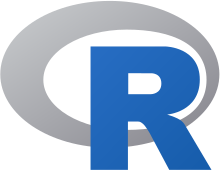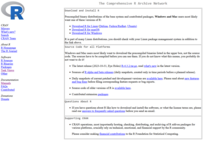R package

R packages are extensions to the R statistical programming language. R packages contain code, data, and documentation in a standardised collection format that can be installed by users of R, typically via a centralised software repository such as CRAN (the Comprehensive R Archive Network).[1][2] The large number of packages available for R, and the ease of installing and using them, has been cited as a major factor driving the widespread adoption of the language in data science.[3][4][5][6]
Compared to libraries in other programming languages, R packages must conform to a relatively strict specification.[3] The Writing R Extensions manual[7] specifies a standard directory structure for R source code, data, documentation, and package metadata, which enables them to be installed and loaded using R's in-built package management tools.[3] Packages distributed on CRAN must meet additional standards.[3][8] According to John Chambers, whilst these requirements "impose considerable demands" on package developers, they improve the usability and long-term stability of packages for end users.[3]
Repositories
[edit]Comprehensive R Archive Network (CRAN)
[edit]
The Comprehensive R Archive Network (CRAN) is R's central software repository, supported by the R Foundation.[9] It contains an archive of the latest and previous versions of the R distribution, documentation, and contributed R packages.[10] It includes both source packages and pre-compiled binaries for Windows and macOS.[11] As of November 2020[update], more than 16,000 packages are available.[12] CRAN was created by Kurt Hornik and Friedrich Leisch in 1997,[13][14] with the name paralleling other early packing systems such as TeX's CTAN (released 1992) and Perl's CPAN (released 1995).[15] As of 2021[update], it is still maintained by Hornik and a team of volunteers.[9] The master site is located at the Vienna University of Economics and Business and is mirrored on servers around the world.[10]

The "Task Views" page (subject list) on the CRAN website[16] lists a wide range of tasks (in fields such as finance, genetics, high performance computing, machine learning, medical imaging, meta-analysis, social sciences and spatial statistics) for which R packages are available. Another way to browse CRAN packages is provided by Metacran,[17] which also maintains lists of featured, most downloaded, trending or most depended upon packages.
The number of CRAN packages has grown exponentially for many years,[18] and as of 2018[update] an average of 21 submissions of new or updated packages were made every day.[6] Since each submission is manually reviewed by a small team of CRAN maintainers, many of whom, according to R core developer Peter Dalgaard, are "approaching pensionable age", there is a concern that this system is not sustainable in the long term.[6] The growth of CRAN has exposed limitations of its dependency management infrastructure, particularly the fact that it assumes that dependencies always refer to the latest version of a package, meaning that new releases of CRAN packages must always be backwards compatible,[19] and that CRAN packages cannot have dependencies that are not on CRAN.[20] It has also led to concerns about declining quality of packages.[21]
MRAN and Posit Package Manager
[edit]
The Microsoft R Application Network (MRAN) is a mirror of CRAN maintained by Microsoft which is based on the company's downstream distribution of R, Microsoft R Open (formerly Revolution R Open).[22] It also includes an archive of daily CRAN snapshots, branded as the "CRAN Time Machine", which enables users of MRAN to bypass the dependency versioning limitations of CRAN by installing a fixed set of R package versions via the package checkpoint.[23][24] In January 2023 Microsoft announced that MRAN was being retired and the associated websites and repositories became unavailable in July 2023.[25]

The Posit Package Manager (formerly RStudio Package Manager) is a similar tool produced by the developers of RStudio which, in addition to CRAN snapshots, includes an archive of R packages from Bioconductor and Python packages from the Python Package Index.[26] It also distributes pre-compiled binary packages for Linux (only Windows and macOS binaries are included on CRAN).[27]
Other repositories
[edit]The Bioconductor project provides R packages for the analysis of genomic data. This includes object-oriented data-handling and analysis tools for data from Affymetrix, cDNA microarray, and next-generation high-throughput sequencing methods.[28]

R-Forge,[29] is a central platform for the collaborative development of R packages, R-related software, and projects. R-Forge also hosts many unpublished beta packages, and development versions of CRAN packages.
Base and recommended packages
[edit]R is distributed with fifteen "base packages": base, compiler, datasets, grDevices, graphics, grid, methods, parallel, splines, stats, stats4, tcltk, tools, translations, and utils.[30]
In addition, there are fifteen "recommended packages" from CRAN which are included with binary distributions of R: KernSmooth, MASS, Matrix, boot, class, cluster, codetools, foreign, lattice, mgcv, nlme, nnet, rpart, spatial, and survival.[30]
Other packages
[edit]A group of packages called the tidyverse, which can be considered a "dialect of the R language", is increasingly popular in the R ecosystem. As of 2020-06-13, Metacran[17] listed 7 of the 8 core packages of the tidyverse in the list of most downloaded R packages. The group of packages strives to provide a cohesive collection of functions to deal with common data science tasks, including data import, cleaning, transformation and visualisation (notably with the ggplot2 package).
The R Infrastructure packages[31] support coding and the development of R packages and as of 2021-05-04, Metacran[17] lists 16 of these packages among the 25 most downloaded packages.
See also
[edit]References
[edit]- ^ Hornik, Kurt (2020-02-20). "Frequently Asked Questions on R". The Comprehensive R Archive Network. 7.29: What is the difference between package and library?. Archived from the original on 2011-07-09. Retrieved 2 November 2020.
{{cite web}}: CS1 maint: location (link) - ^ Wickham, Hadley; Bryan, Jennifer. "Introduction". R Packages (2nd ed.). Archived from the original on 2022-06-29. Retrieved 2020-11-02.
- ^ a b c d e Chambers, John M. (2020). "S, R, and Data Science". The R Journal. 12 (1): 462–476. doi:10.32614/RJ-2020-028. ISSN 2073-4859. Archived from the original on 2020-11-01. Retrieved 2020-11-02.
- ^ Vance, Ashlee (2009-01-06). "Data Analysts Captivated by R's Power". New York Times. Archived from the original on 2021-05-02. Retrieved 2020-11-02.
- ^ Tippmann, Sylvia (2014-12-29). "Programming tools: Adventures with R". Nature News. 517 (7532): 109–110. doi:10.1038/517109a. PMID 25557714.
- ^ a b c Thieme, Nick (2018). "R generation". Significance. 15 (4): 14–19. doi:10.1111/j.1740-9713.2018.01169.x. ISSN 1740-9713.
- ^ "Writing R Extensions". The Comprehensive R Archive Network. Archived from the original on 2020-11-12. Retrieved 2020-11-02.
- ^ "CRAN Repository Policy". The Comprehensive R Archive Network. Archived from the original on 2020-11-05. Retrieved 2020-11-02.
- ^ a b CRAN Repository Maintainers. "CRAN Repository Policy". The Comprehensive R Archive Network. R Project. Archived from the original on 11 November 2020. Retrieved 20 November 2020.
- ^ a b Hornik, Kurt (2020-02-20). "Frequently Asked Questions on R". The Comprehensive R Archive Network. 2.1: What is CRAN?: R Project. Archived from the original on 2011-07-09. Retrieved 20 November 2020.
{{cite web}}: CS1 maint: location (link) - ^ CRAN Repository Maintainers. "The Comprehensive R Archive Network". R Project. Archived from the original on 23 January 2019. Retrieved 20 November 2020.
- ^ CRAN Repository Maintainers. "CRAN - Contributed Packages". The Comprehensive R Archive Network. CRAN. Archived from the original on 24 November 2020. Retrieved 20 November 2020.
- ^ Hornik, Kurt (1997-04-23). "ANNOUNCE: CRAN". r-announce (Mailing list). Archived from the original on 2021-03-08. Retrieved 20 November 2020.
- ^ Thieme, Nick (2018). "R generation". Significance. 15 (4): 14–19. doi:10.1111/j.1740-9713.2018.01169.x. ISSN 1740-9713.
- ^ Fitzgerald, Brian (2016-02-09). "A Survey of Programming Language Package Systems". Some Things Are Obvious. Archived from the original on 2020-11-09. Retrieved 4 May 2021.
- ^ "CRAN Task Views". cran.r-project.org. Archived from the original on 2011-07-09. Retrieved 2018-09-16.
- ^ a b c "Metacran". Archived from the original on 2021-04-20. Retrieved 2021-05-04.
- ^ Asay, Matt (April 21, 2016). "Exponential growth of R's open source community threatens commercial competitors". TechRepublic. Archived from the original on 2020-10-26. Retrieved 2020-11-02.
- ^ Ooms, Jeroen (2013). "Possible Directions for Improving Dependency Versioning in R". The R Journal. 5 (1): 197–206. arXiv:1303.2140. doi:10.32614/RJ-2013-019. ISSN 2073-4859. S2CID 6791850. Archived from the original on 2020-09-19. Retrieved 2020-11-02.
- ^ Decan, A.; Mens, T.; Claes, M.; Grosjean, P. (2016). "When GitHub Meets CRAN: An Analysis of Inter-Repository Package Dependency Problems". 2016 IEEE 23rd International Conference on Software Analysis, Evolution, and Reengineering (SANER). Vol. 1. pp. 493–504. doi:10.1109/SANER.2016.12. ISBN 978-1-5090-1855-0. S2CID 16751624. Archived from the original on 2021-01-16. Retrieved 2021-05-12.
- ^ Hornik, Kurt (2012). "Are There Too Many R Packages?". Austrian Journal of Statistics. 41 (1): 59–66–59–66. doi:10.17713/ajs.v41i1.188. ISSN 1026-597X. Archived from the original on 2020-11-26. Retrieved 2020-11-02.
- ^ "Welcome to MRAN". Microsoft R Application Network. Microsoft. Archived from the original on 4 May 2021. Retrieved 4 May 2021.
- ^ "Reproducibility: Using Fixed CRAN Repository Snapshots". Microsoft R Application Network. Microsoft. Archived from the original on 2 May 2021. Retrieved 4 May 2021.
- ^ Smith, David (2019-05-22). "MRAN snapshots, and you". Revolutions. Revolution Analytics. Archived from the original on 2021-05-04. Retrieved 4 May 2021.
- ^ "Microsoft R Application Network retirement". techcommunity.microsoft.com. Retrieved 2023-11-15.
- ^ Lopp, Sean (2020-12-07). "RStudio Package Manager 1.2.0 - Bioconductor & PyPI". RStudio Blog. RStudio. Archived from the original on 2021-05-04. Retrieved 4 May 2021.
- ^ Lopp, Sean (2020-07-01). "Announcing Public Package Manager and v1.1.6". RStudio Blog. RStudio. Archived from the original on 2021-05-04. Retrieved 4 May 2021.
- ^ Huber, W; Carey, VJ; Gentleman, R; Anders, S; Carlson, M; Carvalho, BS; Bravo, HC; Davis, S; Gatto, L; Girke, T; Gottardo, R; Hahne, F; Hansen, KD; Irizarry, RA; Lawrence, M; Love, MI; MacDonald, J; Obenchain, V; Oleś, AK; Pagès, H; Reyes, A; Shannon, P; Smyth, GK; Tenenbaum, D; Waldron, L; Morgan, M (2015). "Orchestrating high-throughput genomic analysis with Bioconductor". Nature Methods. 12 (2). Nature Publishing Group: 115–121. doi:10.1038/nmeth.3252. PMC 4509590. PMID 25633503.
- ^ "R-Forge: Welcome". Archived from the original on 2018-09-14. Retrieved 2018-09-16.
- ^ a b Hornik, Kurt (2020-02-20). "Frequently Asked Questions on R". The Comprehensive R Archive Network. 5.1: Which add-on packages exist for R?. Archived from the original on 2011-07-09. Retrieved 2 November 2020.
{{cite web}}: CS1 maint: location (link) - ^ "R infrastructure". GitHub. Archived from the original on 2021-05-19. Retrieved 2021-05-04.
Further reading
[edit]- Claes, M.; Mens, T.; Grosjean, P. (2014). "On the maintainability of CRAN packages". 2014 Software Evolution Week - IEEE Conference on Software Maintenance, Reengineering, and Reverse Engineering (CSMR-WCRE). pp. 308–312. doi:10.1109/CSMR-WCRE.2014.6747183. ISBN 978-1-4799-3752-3. S2CID 17927576.
- Decan, Alexandre; Mens, Tom; Claes, Maelick; Grosjean, Philippe (2015-09-07). "On the Development and Distribution of R Packages". Proceedings of the 2015 European Conference on Software Architecture Workshops. ECSAW '15. Dubrovnik, Cavtat, Croatia: Association for Computing Machinery. pp. 1–6. doi:10.1145/2797433.2797476. ISBN 978-1-4503-3393-1. S2CID 1680582.
- Fox, John (2009). "Aspects of the Social Organization and Trajectory of the R Project". The R Journal. 1 (2): 5–13. doi:10.32614/RJ-2009-014. ISSN 2073-4859.
- Fox, John; Leanage, Allison (12 September 2016). "R and the Journal of Statistical Software". Journal of Statistical Software. 73 (1): 1–13. doi:10.18637/jss.v073.i02. ISSN 1548-7660.
- Plakidas, Konstantinos; Schall, Daniel; Zdun, Uwe (2017). "Evolution of the R software ecosystem: Metrics, relationships, and their impact on qualities". Journal of Systems and Software. 132: 119–146. doi:10.1016/j.jss.2017.06.095. ISSN 0164-1212.
External links
[edit]- The Comprehensive R Archive Network (CRAN)
- METACRAN, a directory of R packages
- CRAN Task Views, listing of CRAN packages by topics

